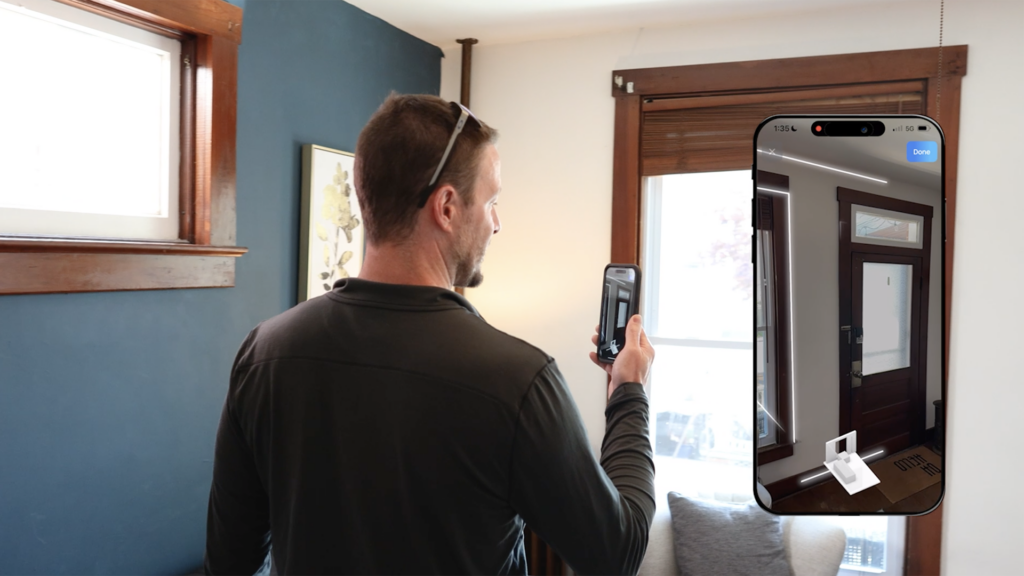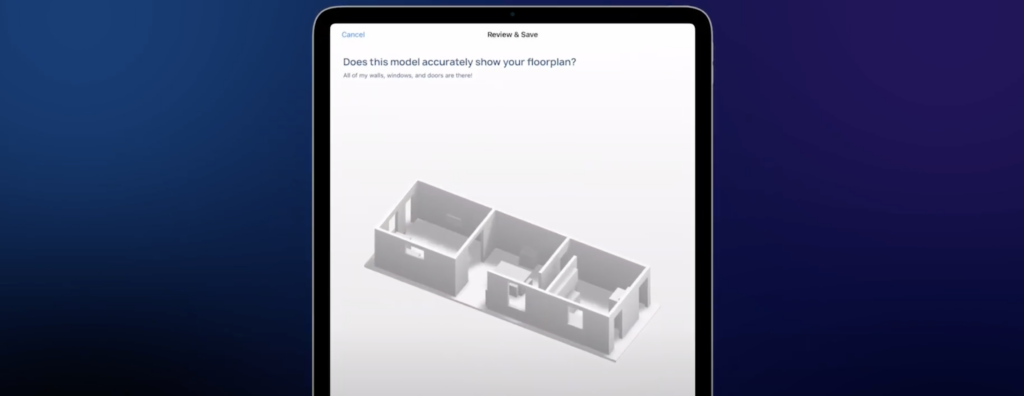The integration of LiDAR scanners in architecture has ushered in a new era of precision and efficiency in building design, planning, and execution. LiDAR scanners, such as those employed by the innovative RENDR app, utilize rapid pulses of light to capture highly detailed 3D measurements of physical spaces. This advanced technology offers architects unparalleled benefits, ranging from enhanced accuracy to improved visualization capabilities, revolutionizing the architectural landscape.

Efficiency and Accuracy
LiDAR scanners enable architects to capture measurements swiftly and accurately, boasting up to 99.6% precision, as validated by RENDR. This level of accuracy is paramount in architecture, where even minor measurement errors can have profound implications for a project’s outcome. LiDAR scanning ensures that architects can rely on precise data, minimizing potential setbacks and streamlining the design process.
By employing LiDAR scanners, architects can efficiently measure entire buildings or sites within seconds, significantly reducing the time spent on traditional manual measurements with tape measures or laser distance meters. The speed and accuracy of LiDAR scanning technology enable architects to capture millions of data points, creating comprehensive 3D models that provide an accurate representation of the existing conditions at a site.

3D Modeling
The data captured by LiDAR scanners serves as the foundation for generating comprehensive 3D models of spaces in near real-time. These models provide architects with a holistic view of the space, empowering them to grasp its layout and features more effectively than traditional 2D plans.
Unlike conventional methods, which often require manual measurements and extensive processing time, LiDAR scanners provide architects with highly detailed point cloud data, representing millions of individual points within a space. This data can be easily transformed into accurate and realistic 3D models, allowing architects to explore the space from various angles and perspectives.
The ability to create detailed 3D models rapidly has a transformative effect on the architectural design process. Architects can leverage these models to gain a deeper understanding of the space, analyze potential design options, and communicate their vision more effectively to clients and stakeholders.

Remote Accessibility
LiDAR technology eliminates the need for architects to be physically present at a site to capture accurate measurements and create detailed models. This remote accessibility is particularly valuable in today’s context, where remote work arrangements have become increasingly necessary.
Architects can now use LiDAR scanners to capture data remotely, minimizing the need for multiple site visits. This not only saves time and travel expenses but also enables architects to work on projects located in different geographical areas. The ability to remotely access accurate data empowers architects to collaborate seamlessly with clients, consultants, and team members, regardless of their physical location.
Furthermore, remote accessibility enhances safety by eliminating the need for surveyors or other professionals to physically climb ladders or access potentially hazardous areas to take measurements manually. Architects can now capture precise measurements and detailed models from the safety of their own offices, reducing the risk of accidents and injuries.
Enhanced Client Collaboration
LiDAR technology enhances client collaboration by providing clients with immersive and tangible experiences. Through detailed 3D models, architects can effectively communicate their designs, allowing clients to visualize the proposed spaces more vividly.
The ability to share interactive 3D models with clients enables architects to engage them in the design process and gather valuable feedback. Clients can explore the virtual representation of the project, understanding the spatial relationships, proportions, and overall aesthetics. This collaborative approach fosters clearer communication, informed decision-making, and ultimately, client satisfaction.
Cost and Time Efficiency
By improving efficiency and enabling remote work, LiDAR technology brings substantial time and cost savings to architectural projects. Architects can bid on more projects in less time, reducing overhead expenses and increasing overall profitability.
The precise and efficient nature of LiDAR scanning minimizes the potential for errors, reducing costly rework and ensuring projects stay within budget and timeline. Architects can rely on accurate measurements and detailed models to make informed design decisions, mitigating the risk of costly design modifications during construction.
Additionally, the ability to quickly capture accurate measurements and generate detailed 3D models allows architects to expedite the design process. This results in faster project turnaround times, enabling architects to take on more projects and increasing their competitiveness in the market.
LiDAR scanners, integrated with advanced applications like RENDR, have revolutionized architecture by providing architects with the ability to capture precise measurements, generate detailed 3D models, and make informed design decisions. The efficiency, accuracy, remote accessibility, enhanced client collaboration, and cost and time savings offered by LiDAR technology have transformed the architectural landscape.
Architects can now leverage the power of LiDAR scanners to streamline their workflow, reduce errors, improve project efficiency, and deliver exceptional designs. As LiDAR technology continues to evolve, its applications within architecture will expand, promising even more exciting possibilities for architects worldwide. Embracing LiDAR scanners is not just a trend; it is a transformative step towards the future of architecture.
Takeaway
LiDAR scanners, integrated with advanced applications like RENDR, have revolutionized architecture by providing architects with the ability to capture precise measurements, generate detailed 3D models, and make informed design decisions. The efficiency, accuracy, remote accessibility, enhanced client collaboration, and cost and time savings offered by LiDAR technology have transformed the architectural landscape.
Architects can now leverage the power of LiDAR scanners to streamline their workflow, reduce errors, improve project efficiency, and deliver exceptional designs. As LiDAR technology continues to evolve, its applications within architecture will expand, promising even more exciting possibilities for architects worldwide. Embracing LiDAR scanners is not just a trend; it is a transformative step towards the future of architecture.
The integration of LiDAR scanners in architecture has ushered in a new era of precision and efficiency in building design, planning, and execution. LiDAR scanners, such as those employed by the innovative RENDR app, utilize rapid pulses of light to capture highly detailed 3D measurements of physical spaces. This advanced technology offers architects unparalleled benefits, ranging from enhanced accuracy to improved visualization capabilities, revolutionizing the architectural landscape.

Efficiency and Accuracy
LiDAR scanners enable architects to capture measurements swiftly and accurately, boasting up to 99.6% precision, as validated by RENDR. This level of accuracy is paramount in architecture, where even minor measurement errors can have profound implications for a project’s outcome. LiDAR scanning ensures that architects can rely on precise data, minimizing potential setbacks and streamlining the design process.
By employing LiDAR scanners, architects can efficiently measure entire buildings or sites within seconds, significantly reducing the time spent on traditional manual measurements with tape measures or laser distance meters. The speed and accuracy of LiDAR scanning technology enable architects to capture millions of data points, creating comprehensive 3D models that provide an accurate representation of the existing conditions at a site.

3D Modeling
The data captured by LiDAR scanners serves as the foundation for generating comprehensive 3D models of spaces in near real-time. These models provide architects with a holistic view of the space, empowering them to grasp its layout and features more effectively than traditional 2D plans.
Unlike conventional methods, which often require manual measurements and extensive processing time, LiDAR scanners provide architects with highly detailed point cloud data, representing millions of individual points within a space. This data can be easily transformed into accurate and realistic 3D models, allowing architects to explore the space from various angles and perspectives.
The ability to create detailed 3D models rapidly has a transformative effect on the architectural design process. Architects can leverage these models to gain a deeper understanding of the space, analyze potential design options, and communicate their vision more effectively to clients and stakeholders.

Remote Accessibility
LiDAR technology eliminates the need for architects to be physically present at a site to capture accurate measurements and create detailed models. This remote accessibility is particularly valuable in today’s context, where remote work arrangements have become increasingly necessary.
Architects can now use LiDAR scanners to capture data remotely, minimizing the need for multiple site visits. This not only saves time and travel expenses but also enables architects to work on projects located in different geographical areas. The ability to remotely access accurate data empowers architects to collaborate seamlessly with clients, consultants, and team members, regardless of their physical location.
Furthermore, remote accessibility enhances safety by eliminating the need for surveyors or other professionals to physically climb ladders or access potentially hazardous areas to take measurements manually. Architects can now capture precise measurements and detailed models from the safety of their own offices, reducing the risk of accidents and injuries.
Enhanced Client Collaboration
LiDAR technology enhances client collaboration by providing clients with immersive and tangible experiences. Through detailed 3D models, architects can effectively communicate their designs, allowing clients to visualize the proposed spaces more vividly.
The ability to share interactive 3D models with clients enables architects to engage them in the design process and gather valuable feedback. Clients can explore the virtual representation of the project, understanding the spatial relationships, proportions, and overall aesthetics. This collaborative approach fosters clearer communication, informed decision-making, and ultimately, client satisfaction.
Cost and Time Efficiency
By improving efficiency and enabling remote work, LiDAR technology brings substantial time and cost savings to architectural projects. Architects can bid on more projects in less time, reducing overhead expenses and increasing overall profitability.
The precise and efficient nature of LiDAR scanning minimizes the potential for errors, reducing costly rework and ensuring projects stay within budget and timeline. Architects can rely on accurate measurements and detailed models to make informed design decisions, mitigating the risk of costly design modifications during construction.
Additionally, the ability to quickly capture accurate measurements and generate detailed 3D models allows architects to expedite the design process. This results in faster project turnaround times, enabling architects to take on more projects and increasing their competitiveness in the market.
LiDAR scanners, integrated with advanced applications like RENDR, have revolutionized architecture by providing architects with the ability to capture precise measurements, generate detailed 3D models, and make informed design decisions. The efficiency, accuracy, remote accessibility, enhanced client collaboration, and cost and time savings offered by LiDAR technology have transformed the architectural landscape.
Architects can now leverage the power of LiDAR scanners to streamline their workflow, reduce errors, improve project efficiency, and deliver exceptional designs. As LiDAR technology continues to evolve, its applications within architecture will expand, promising even more exciting possibilities for architects worldwide. Embracing LiDAR scanners is not just a trend; it is a transformative step towards the future of architecture.
Takeaway
LiDAR scanners, integrated with advanced applications like RENDR, have revolutionized architecture by providing architects with the ability to capture precise measurements, generate detailed 3D models, and make informed design decisions. The efficiency, accuracy, remote accessibility, enhanced client collaboration, and cost and time savings offered by LiDAR technology have transformed the architectural landscape.
Architects can now leverage the power of LiDAR scanners to streamline their workflow, reduce errors, improve project efficiency, and deliver exceptional designs. As LiDAR technology continues to evolve, its applications within architecture will expand, promising even more exciting possibilities for architects worldwide. Embracing LiDAR scanners is not just a trend; it is a transformative step towards the future of architecture.